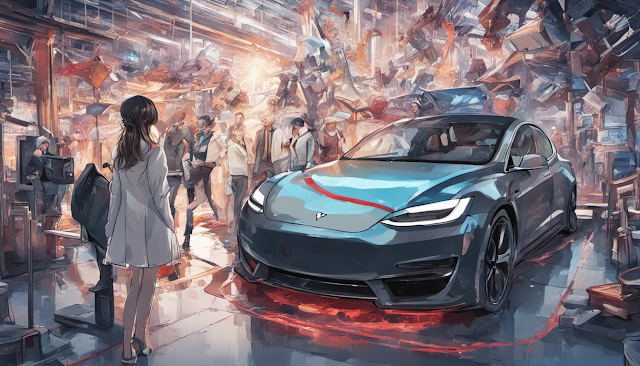Introduction to Tesla Autopilot
In the realm of modern automotive innovation, Tesla Autopilot has been a frontrunner, moving the limitations of what we thought was attainable in the world of electric vehicles.
One of the standout segments that has garnered tremendous engagement and acclaim is the Tesla Autopilot system. This rebellious technology has redefined the way we sense driving, bringing us closer to the age of self-driving cars.
 |
| dreamstudio |
In this article, we will go into the complexities of how Tesla Autopilot works, shedding light on the underlying technologies, capabilities, and its impact on the future of transportation.
How Does Tesla Autopilot Work?
Tesla Autopilot is an advanced driver assistance system (ADAS) that can help drivers with dynamic driving tasks (DDT) like steering, braking, and accelerating. It is not a self-driving system, and drivers are still accountable for scanning the road and taking over at all times.
Tesla Autopilot uses a variety of cameras, radar, and ultrasonic sensors to sense the car's surroundings. The cameras are used to recognize lane markings, traffic signs, and other objects.
The radar is used to notice objects that are further away, such as other cars and pedestrians. The ultrasonic sensors are used to detect objects that are close to the car, like curbs, and other vehicles.
The Tesla Autopilot system uses this data to calculate the car's position and velocity and to anticipate the motions of other objects in the environment. The system then uses this input to control the car's steering, braking, and acceleration.
Understanding the Basics of Tesla Autopilot
Tesla Autopilot is an advanced driver-assistance system (ADAS) that employs a variety of hardware and software to facilitate a vehicle to partially control itself. It is designed to enrich safety, reduce driver fatigue, and deliver an overall more pleasant driving experience.
Key components of Tesla Autopilot
1. Cameras
Tesla vehicles are fitted with a network of cameras strategically placed around the car. These cameras provide a 360-degree view of the vehicle's surroundings, stimulating it to perceive objects, lane markings, traffic lights, and other basic elements of the road.
2. Ultrasonic Sensors
In addition to cameras, Tesla vehicles also feature ultrasonic sensors. These sensors use sound waves to detect objects and obstacles close to the car, helping with parking, avoiding collisions, and maintaining a safe distance from other vehicles.
3. Radar
Tesla Autopilot system depends on radar technology to detect objects at longer distances and in difficult weather conditions. Radar is particularly effective in conditions where visibility is compromised, such as heavy rain or fog.
4. Enhanced Processing
The data collected by cameras, sensors, and radar is processed by a powerful onboard computer. This computer, trained with advanced machine learning algorithms, interprets the data in real-time to make driving decisions.
The Three Pillars of Tesla Autopilot
Tesla Autopilot operates on three fundamental principles:
1. Traffic-Aware Cruise Control (TACC)
TACC is the foundation of Tesla Autopilot. It allows the vehicle to maintain a set speed while adjusting its pace based on the traffic flow. The car can slow down, speed up, and even come to a complete stop if necessary, all while keeping a safe distance from the vehicle in front.
2. Autosteer
Autosteer takes TACC to the next level by adding steering control. With Autosteer engaged, the Tesla vehicle can navigate within a lane, following curves and turns on the highway. However, it's essential to remark that the driver must remain engaged and ready to take control at any moment.
3. Navigate on Autopilot
This feature allows the vehicle to autonomously change lanes, exit the highway, and even take highway interchanges. It can be considered a more advanced version of Autosteer, making long highway drives more convenient.
The Role of Over-the-Air Updates
Tesla's dedication to innovation goes beyond just the hardware in its vehicles. One of the most outstanding aspects of Tesla's Autopilot system is its command to improve over time through over-the-air (OTA) software updates.
This means that as Tesla engineers develop new features, improve existing ones, and improve safety measures, these advancements can be seamlessly downloaded and installed on your Tesla vehicle.
Safety and Limitations
While Tesla Autopilot is a groundbreaking technology, it's important to understand its limitations. Tesla highlights that Autopilot is not a fully autonomous system. It requires active supervision and intervention from the driver at all times.
Further, the system may not function optimally in all driving conditions, such as heavy snow or extremely complex city environments.
The Future of Tesla Autopilot
Tesla Autopilot system is constantly growing, bringing us closer to the reality of self-driving cars. Elon Musk, Tesla's CEO, imagines a future where Autopilot will be adept at handling complex urban driving and even fully autonomous operations.
While we are not there yet, Tesla's rigorous pursuit of innovation suggests that the future of transportation is set to be safer, more efficient, and more enjoyable than ever before.
 |
| dreamstudio |
Conclusion
Tesla Autopilot symbolizes a gigantic leap in automotive technology. By combining cameras, sensors, radar, and powerful onboard processing, Tesla has created a system that improves both the safety and convenience of driving.
While the road to fully self-supported vehicles is still unfolding, Tesla is undeniably at the fore of this exciting journey, shaping the future of transportation one update at a time.









0 Comments